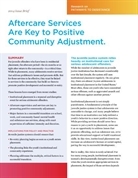pathways to desistance
-
 2014 Issue Brief: Aftercare Services are Key to Positive Community Adjustment
2014 Issue Brief: Aftercare Services are Key to Positive Community Adjustment
- Dec 8, 2014, Models for Change Resource Center Partnership
- SUMMARY
For young offenders who, for public safety reasons, cannot remain in the community, placement is still more than mere punishment. It is also an opportunity to provide services that address…
-
 2014 Issue Brief: Give Adolescents the Time and Skills to Mature, and Most Offenders Will Stop
2014 Issue Brief: Give Adolescents the Time and Skills to Mature, and Most Offenders Will Stop
- Dec 8, 2014, Models for Change Resource Center Partnership
- SUMMARY
Pathways to Desistance, a major, long-term study of serious juvenile offenders, has shown that:
Adolescents, including serious juvenile offenders, naturally mature—psychologically,…
-
 2014 Issue Brief: To Decrease Juvenile Offending, Make Effective Drug Treatment a Priority
2014 Issue Brief: To Decrease Juvenile Offending, Make Effective Drug Treatment a Priority
- Dec 8, 2014, Models for Change Resource Center Partnership
- Substance use is prevalent among juvenile offenders, and predicts both continued offending and a less successful transition to adulthood. Yet many juvenile offenders with drug problems go untreated.…
-
 2014 Issue Brief: Programs that Promote Positive Development Can Help Young Offenders Grow Up and Out of Crime
2014 Issue Brief: Programs that Promote Positive Development Can Help Young Offenders Grow Up and Out of Crime
- Dec 8, 2014, Models for Change Resource Center Partnership
- Serious juvenile offenders, like other young people, have the potential for growth and change. Multiple studies have shown that maturity and reduced offending are closely intertwined. The question…
-
 2014 Knowledge Brief: Perceptions and Outcomes in Adolescent Confinement
2014 Knowledge Brief: Perceptions and Outcomes in Adolescent Confinement
- Dec 8, 2014, Models for Change Resource Center Partnership
- While the content of programming in juvenile facilities has been the subject of much study, there has been less work on the broader “institutional environment” and its effect on outcomes.…
-
 2014 Issue Brief: To Monitor Changing Risks and Needs, Repeat Assessment of Young Offenders Over Time
2014 Issue Brief: To Monitor Changing Risks and Needs, Repeat Assessment of Young Offenders Over Time
- Dec 8, 2014, Models for Change Resource Center Partnership
- Valid, practical screening and assessment tools are now available to evaluate juvenile offenders’ risks for future criminal involvement and their case management needs. Analyses from the…
-
 2014 Issue Brief: Smarter Use of Placement Can Improve Outcomes for Youth and Communities
2014 Issue Brief: Smarter Use of Placement Can Improve Outcomes for Youth and Communities
- Dec 8, 2014, Models for Change Resource Center Partnership
- SUMMARY
Because institutional placement is likely to remain in use, especially for serious or chronic offenders, juvenile justice systems need to understand its effects and how to use it to improve…